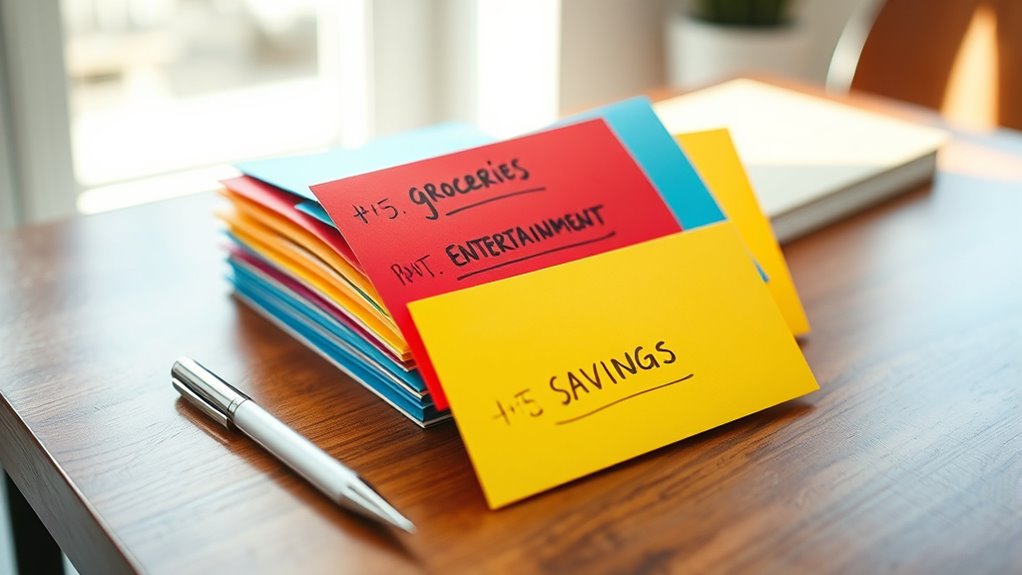Yes, the envelope budgeting method still works and remains popular for managing personal finances. Whether you prefer physical envelopes with cash or digital ones via apps, it helps you stay disciplined by allocating specific funds to different categories. This simple system encourages mindful spending, prevents overspending, and helps you reach savings goals. As long as you stay consistent, envelope budgeting can be a powerful tool—more tips are just ahead to enhance your financial control.
Key Takeaways
- Envelope budgeting promotes disciplined spending by allocating cash or digital funds to specific categories, fostering financial awareness.
- Both physical and digital envelopes remain effective tools for controlling expenses and avoiding overspending when used consistently.
- The method’s success depends on discipline and honest tracking, not the format, making it adaptable to modern financial habits.
- Digital envelope systems offer added convenience, automation, and real-time tracking, enhancing the traditional method’s relevance today.
- While not foolproof, envelope budgeting continues to be a practical, straightforward strategy for managing personal finances effectively.

Have you ever struggled to stick to a budget and control your spending? If so, you’re not alone. Many people find it challenging to manage their finances without feeling deprived or overwhelmed. One effective method that has stood the test of time is the envelope budgeting system. Traditionally, this approach involves using physical envelopes to allocate cash for different spending categories—groceries, entertainment, gas, and so on. You put the designated amount of cash into each envelope at the start of the month, and once it’s gone, you stop spending in that category. This tangible method helps you visually see how much you have left, making it easier to resist impulse purchases. But the landscape of personal finance has evolved, and so has the envelope system. Today, many turn to digital envelopes, which mimic the physical method but use apps or online tools to allocate funds electronically. Digital envelopes offer the convenience of managing your budget from your phone or computer, eliminating the need to carry cash. You can create virtual envelopes for each spending category, set limits, and transfer funds instantly. This modern twist maintains the core principle—spending only what you’ve allocated—while adding flexibility. Whether you prefer cash envelopes or digital envelopes depends on your lifestyle and comfort with technology. Cash envelopes force you to physically handle money, making the spending feel more real and immediate. Some find that this tactile experience helps them stay disciplined. On the other hand, digital envelopes cater to those who prefer a more streamlined, tech-savvy approach. They often sync with your bank accounts, automatically track transactions, and generate reports to help you analyze your spending habits. Both methods encourage mindfulness about how you use your money, making it easier to avoid unnecessary expenses and reach your savings goals. One of the biggest advantages of the envelope system, in either form, is its simplicity. You don’t need complex software or detailed spreadsheets; you just need a system that clearly delineates your funds. Plus, by sticking to predefined amounts, you develop better awareness of your financial limits. That said, the envelope budgeting method isn’t foolproof. It requires discipline, regular tracking, and honest assessment of your spending patterns. For some, the physical cash can be a temptation, and digital envelopes might tempt you to overspend if you’re not vigilant. Interestingly, understanding local divorce statistics and how regional legal resources operate can serve as a reminder of the importance of financial planning and stability. Nonetheless, many find that combining the traditional and digital approaches can maximize their effectiveness. You might use cash envelopes for everyday expenses and digital envelopes for savings or irregular bills. Ultimately, envelope budgeting remains a flexible and straightforward way to gain control over your finances, whether you prefer the tactile feel of cash or the convenience of digital tools.
Frequently Asked Questions
Can Envelope Budgeting Work for High-Income Earners?
Yes, envelope budgeting can work for high-income earners. You can allocate funds for luxury spending, ensuring it doesn’t interfere with your savings goals. By dividing your income into specific envelopes, you maintain control over expenses and prevent overspending on non-essentials. This method helps you stay disciplined, even with a higher income, and keeps your financial priorities clear while enjoying your wealth responsibly.
How Do Digital Tools Compare to Cash Envelopes?
Digital apps often offer more convenience and flexibility compared to traditional cash envelopes. They allow you to easily track spending, set budgets, and adjust categories as needed. When doing an envelope comparison, you’ll notice digital tools eliminate the risk of losing cash and make syncing across devices simple. Plus, they provide real-time updates, helping you stay on top of your finances without carrying physical envelopes.
Is Envelope Budgeting Suitable for Irregular Income?
Think of your income as a river’s flow—irregular but constant. Envelope budgeting can work if you adapt it, setting flexible envelopes that accommodate fluctuating cash flow. You might allocate more during high-income months and less when income drops, maintaining budgeting flexibility. This approach helps you stay organized and mindful of spending, even with inconsistent income, making the envelope method a practical tool for managing your finances effectively.
What Are Common Challenges When Transitioning to Envelope Budgeting?
You might face challenges when shifting to envelope budgeting, especially with your cash flow and spending habits. It can be difficult to stick to set cash limits if you’re used to flexible spending. You may also struggle to allocate funds accurately, leading to overspending or money shortages. Adjusting your habits takes time, and maintaining discipline is vital to guarantee your cash flow stays balanced and your spending aligns with your financial goals.
How Flexible Is the Envelope System During Unexpected Expenses?
You can maintain cash flexibility during unexpected expenses by allocating a portion of your envelope for emergencies. This way, when surprises happen, you don’t have to dip into other budgets or emergency funds immediately. Instead, you can cover unexpected costs with cash set aside, making your system adaptable. Just remember to replenish that envelope after use, ensuring your emergency funds stay intact for future unforeseen expenses.
Conclusion
Imagine your money as colorful envelopes, each one holding a specific purpose, ready to be opened only when needed. The envelope budgeting method still works if you’re disciplined enough to keep your hands out of other envelopes. It’s like guiding your finances through a well-lit path, where each envelope is a milestone. Stay committed, and this simple, visual approach can help you stay on track and achieve your financial goals, one envelope at a time.









